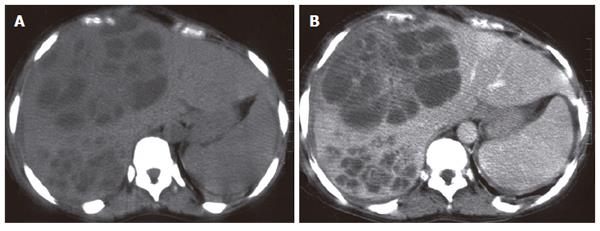Published online May 14, 2006. doi: 10.3748/wjg.v12.i18.2962
Revised: May 28, 2005
Accepted: June 2, 2005
Published online: May 14, 2006
Multiple pyogenic liver abscesses have been rarely described. We report a fatal case of multiple pyogenic liver abscesses affecting a 38-year-old woman requiring surgical drainage. Evolution was marked by occurrence of a septic shock with multi-organ system failure. The patient died 48 h after surgery. Causes, therapeutics and outcome of the disease are discussed.
- Citation: Bahloul M, Chaari A, Bouaziz-Khlaf N, Kallel H, Herguefi L, Chelly H, Hamida CB, Bouaziz M. Multiple pyogenic liver abscess. World J Gastroenterol 2006; 12(18): 2962-2963
- URL: https://www.wjgnet.com/1007-9327/full/v12/i18/2962.htm
- DOI: https://dx.doi.org/10.3748/wjg.v12.i18.2962
The mortality rate of pyogenic liver abscess is 11%-31%[1]. The overall mortality is high in patients with multiple liver abscesses[2]. However, multiple pyogenic liver abscesses are not frequently reported in the literature. We report a fatal case of multiple and gigantic liver abscess affecting a 38-year-old woman.
A 38-year-old woman was admitted to our hospital for abdominal pain in the right upper quadrant, fever, vomiting and anorexia as well as chills and jaundice. On examination she had marked tenderness in the right upper quadrant. The temperature was 40.1 °C, the pulse was 119, and the respiratory rate was 30/min. The blood pressure was 80/30 mmHg. The patient did not drink alcohol.
Laboratory tests performed on admission revealed 41.5% hematocrit, 26 300 white-cell count (per mm3), 62 000 platelet count (per mm3), 30% prothrombin time, 269 μmol/L total bilirubin, 170 μmol/L conjugated bilirubin, 11 mmol/L urea nitrogen, 42 μmol/L creatinine, 4.5 mmol/L glucose, 117 mmol/L sodium, 4 mmol/L potassium, 87mmol/L chloride, 16 mmol/L carbon dioxide, 51U/L aspartate aminotransferase, 21 U/L alanine aminotransferase and 208 U/L creatine kinase.
Ultrasonography of the abdomen revealed that the hepatic parenchyma appeared diffusely heterogeneous, with hypoechoic foci in the right lobe, suggesting the presence of abscess or multiple hydatid cysts.
CT scan of the abdomen (Figures 1A-B) before and after intravenous injection of contrast material confirmed the presence of multiple irregular abscesses varying in size, predominantly in the right lobe of the liver.
Microbiological culture was performed (hemoculture) and the patient received intravenously cefotaxime, gentamicin, metronidazole, omeprazole, fluid, and electrolytes. Surgical drainage was performed 48 h after hospital admission. Escherichia coli, Bacteroides fragilis and prevotella oralis were found in cultures of the pus.
Evolution was marked by occurrence of septic shock with multi-organ system failure. The patient died 48 h after surgery.
Pyogenic liver abscesses are found in 0.3%-1.4% of autopsies[3]. Patients with diabetes mellitus, immune deficiency, sickle cell anemia, malignancy, and liver transplants are at a greater risk for developing liver abscess[1]. The majority of pyogenic liver abscesses are caused by infection originating in the biliary or intestinal tracts[4]. About 10% of pyogenic liver abscesses develop as a result of bacteria entering the liver via the hepatic artery[5]. In the majority of cases, more than one organism has been isolated from their abscesses[6]. The most commonly infecting organisms are Gram-negative aerobes and Escherichia coli is the most frequently encountered[7]. In our case three organisms were identified, suggesting that pyogenic liver abscesses are caused by infection originating in the intestinal tract. Without appropriate diagnosis and treatment, pyogenic liver abscesses are almost uniformly fatal[2,4]. Early diagnosis as well as treatment with appropriate antibiotics and selective drainage can substantially reduce mortality. Our observation has confirmed this hypothesis.
Antibiotic therapy should include penicillin, which is effective against E coli, K pneumonia, bacteroides, enterococcus, and anaerobic streptococci[1]. Antibiotics alone are effective for only a few patients and most patients require percutaneous aspiration or catheter drainage guided by ultrasonography or computed tomography[1]. In our case open surgery was performed because the patient suffered from multiple liver abscesses and septic shock.
The overall mortality may be as high as 30%-40% in patients with multiple liver abscesses, malignant biliary obstruction, inadequate drainage, and immunodeficiency[1,2]. In our case no pathological antecedent was found, however we cannot exclude immunodeficiency in this woman.
S- Editor Wang J L- Editor Wang XL E- Editor Bi L
| 1. | Rahimian J, Wilson T, Oram V, Holzman RS. Pyogenic liver abscess: recent trends in etiology and mortality. Clin Infect Dis. 2004;39:1654-1659. [PubMed] [DOI] [Cited in This Article: ] [Cited by in Crossref: 391] [Cited by in F6Publishing: 364] [Article Influence: 18.2] [Reference Citation Analysis (0)] |
| 2. | Schiff E, Pick N, Oliven A, Odeh M. Multiple liver abscesses after dental treatment. J Clin Gastroenterol. 2003;36:369-371. [PubMed] [DOI] [Cited in This Article: ] [Cited by in Crossref: 15] [Cited by in F6Publishing: 16] [Article Influence: 0.8] [Reference Citation Analysis (0)] |
| 3. | Greenstein AJ, Lowenthal D, Hammer GS, Schaffner F, Aufses AH Jr. Continuing changing patterns of disease in pyogenic liver abscess: a study of 38 patients. Am J Gastroenterol. 1984;79:217-226. [PubMed] [Cited in This Article: ] |
| 4. | Pitt HA. Pyogenic hepatic abscesses. Schiff's Diseases of the Liver, 8th ed. Philadelphia: Lippincott-Raven 1999; 1515-1526. [Cited in This Article: ] |
| 5. | Huang CJ, Pitt HA, Lipsett PA, Osterman FA Jr, Lillemoe KD, Cameron JL, Zuidema GD. Pyogenic hepatic abscess. Changing trends over 42 years. Ann Surg. 1996;223:600-607; discussion 600-607;. [PubMed] [DOI] [Cited in This Article: ] [Cited by in Crossref: 369] [Cited by in F6Publishing: 312] [Article Influence: 11.1] [Reference Citation Analysis (0)] |
| 6. | Pitt HA. Liver abscess. Surgery of the Alimentary Tract, 4th ed. Philadelphia: Saunders 1997; 443-465. [Cited in This Article: ] |
| 7. | Sherlock S, Dooley J. Diseases of the Liver and Biliary System, 10th ed. Oxford: Blackwell Scientific 1997; 497-501. [Cited in This Article: ] |









